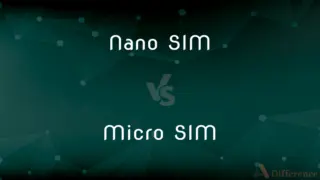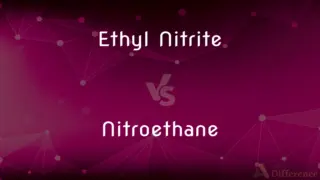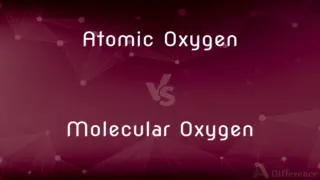Eluate vs. Eluent — What's the Difference?
By Tayyaba Rehman — Updated on November 2, 2023
Eluate is the solution that emerges from an elution process, while eluent is the solvent used in the elution process.

Difference Between Eluate and Eluent
Table of Contents
ADVERTISEMENT
Key Differences
Eluate is the liquid that results from the process of elution, in which a substance is washed out of a matrix. It is essentially the ‘output’ or product of elution. The eluate is what is collected after it has passed through the chromatography column, carrying with it the analyte of interest that has been separated from other substances.
Eluent, on the other hand, refers to the liquid or gas that passes through the chromatography column, which causes the elution to occur. It is the ‘input’ or eluting agent used to effect the separation process. The choice of eluent is critical, as it must effectively displace the desired analyte from the stationary phase of the chromatography apparatus.
In the context of chromatography, both eluate and eluent play pivotal roles. The eluent is selected based on its ability to carry the analyte through the column, whereas the eluate is the focus of analysis, as it contains the analyte after the separation process has been completed.
Eluate can vary in composition depending on the substance being eluted and the eluent used. The eluent's composition is chosen based on the specific requirements of the chromatography or the purification process being conducted.
In summary, the eluent is the means, a chemical facilitator, whereas the eluate is the end, the substance of interest that is obtained after the elution process.
ADVERTISEMENT
Comparison Chart
Definition
The solution obtained from the elution process.
The solvent used in the elution process.
Role in Chromatography
Product of the process, containing the analyte.
Initiator of the process, facilitating separation.
Dependence
Depends on the eluent to be formed.
Independent, chosen based on requirements.
Variation
Varies with the substance being eluted.
Varies with the type of elution process.
Collection
Collected after passing through the column.
Used to pass through and initiate elution.
Compare with Definitions
Eluate
The product of a chromatographic column.
They examined the eluate for impurities.
Eluent
Mobile phase in chromatography.
A non-polar eluent was used for the lipid analysis.
Eluate
Extracted substance in solution form.
The desired eluate was finally obtained after several passes.
Eluent
Liquid facilitating analyte displacement.
They prepared a buffered eluent for the experiment.
Eluate
Outcome of a washing process.
The eluate from the blood samples was ready for testing.
Eluent
Solvent used for elution.
The choice of eluent is crucial for the separation success.
Eluate
Solution resulting from elution.
The eluate was collected for further analysis.
Eluent
Medium carrying substances through a column.
The eluent must be pure to prevent contamination.
Eluate
Liquid containing separated analyte.
This eluate shows a high concentration of the target compound.
Eluent
Agent causing extraction in elution.
The acidic eluent helped to elute the protein more effectively.
Eluate
A solution obtained by elution.
Eluent
A substance used as a solvent in separating materials in elution.
Eluate
The solution of solvent and dissolved matter resulting from elution.
Eluent
(analytical chemistry) In chromatography, a solvent used in order to effect separation by elution.
Eluate
A liquid solution that results from elution
Eluate
To subject or be subjected to elution
Eluate
A liquid solution that results from elution
Common Curiosities
What is eluate?
Eluate is the solution that comes out of a chromatographic process containing the analyte.
What is eluent?
Eluent is the solvent that carries substances through a chromatographic column.
Can eluent and eluate be the same substance?
No, eluent is the solvent used, while eluate is the solution containing the analyte after separation.
Can the pH of the eluent be adjusted?
Yes, adjusting the pH of the eluent can help in the selective elution of analytes.
What factors affect the composition of an eluate?
The composition of the eluent, the matrix, and the conditions of elution affect the eluate.
Is eluate always liquid?
Typically, yes, eluate is the liquid containing the analyte post-elution.
Does the nature of eluent affect the eluate?
Absolutely, the eluent's composition directly affects the eluate's composition.
How do you choose an eluent?
An eluent is chosen based on its ability to dissolve and carry the analyte.
Are eluate and eluent used outside chromatography?
They are primarily used in the context of chromatography and similar separation sciences.
Is it possible to reuse eluent?
In some systems, eluent can be recycled and reused.
Can any liquid be used as an eluent?
Not all liquids can be used; the eluent must be compatible with the stationary phase and able to dissolve the analytes.
Can the eluate contain more than one analyte?
Yes, eluate can contain multiple analytes if they elute together.
What's the difference between eluate and effluent?
Eluate is specific to the elution process, while effluent generally refers to outflowing liquid, often in environmental contexts.
Is the flow rate of eluent important?
Yes, the flow rate can affect the resolution and time of the separation process.
How is the purity of an eluate assessed?
Purity can be assessed via various analytical methods such as spectroscopy or chromatography.
Share Your Discovery

Previous Comparison
Enterprise vs. Venture
Next Comparison
Depth vs. ScopeAuthor Spotlight
Written by
Tayyaba RehmanTayyaba Rehman is a distinguished writer, currently serving as a primary contributor to askdifference.com. As a researcher in semantics and etymology, Tayyaba's passion for the complexity of languages and their distinctions has found a perfect home on the platform. Tayyaba delves into the intricacies of language, distinguishing between commonly confused words and phrases, thereby providing clarity for readers worldwide.















































